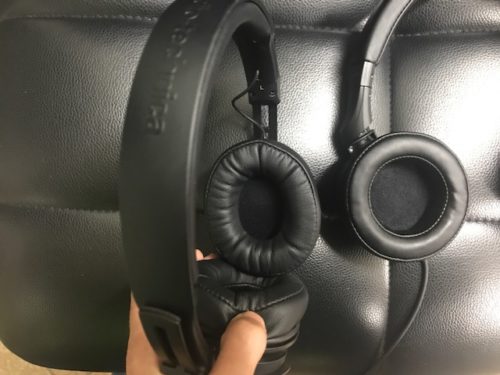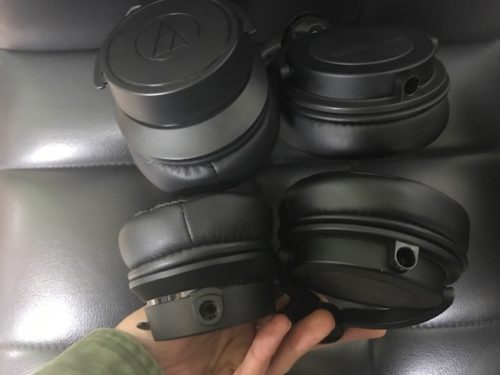We at MajorHiFi love talking about the Beyerdynamic DT 240. What a bunch of geeks. Indeed, my sound engineer buddies swear by them in terms of balance, accuracy, value for money and cuteness. But now we have the M60x, and it’s been heralded as a super honest headphone that works great for mixing and critical listening. It’s also the same on-ear size as the DT 240. Being 100 bucks more expensive than the Beyerdynamic, I wonder if it’s worth the extra money. And anyway, which one is more fun? Let’s explore further in this Audio-Technica ATH-M60x vs Beyerdynamic DT 240 Pro Review.
Audio-Technica ATH-M60x vs Beyerdynamic DT 240 Pro Review
FIT
Both headphones are comfortable to wear for long periods of time. But the M60x is a little looser around the ears. It also has thicker, more luxurious ear pads. Both are about equal in terms of sound isolation.

DESIGN
Both headphones have detachable cables. But the DT 240 Pro allows you to plug in the cable from either ear cup.
Speaking of cables, here’s the deal:
The M60x has 3.9 to 9.8′ / 1.19 to 2.99 meter coiled cable, a 2.99 meter straight cable, and a 1.19 cable. The jacks are 3.5mm with a ¼” adapter.
The DT 240 has only a 1.5 to 3 meter coiled cable, but the coil is small in size and easier to handle than it is on the M60x.
In terms of portability, the DT 240 is a better choice because it swivels flat. The M60x is bulkier and doesn’t fold. It’s more of a hang-it-on-your-mic-stand kind of headphone. But both headphones look durable enough to be tossed around a bit.

SOUND
Overall Impressions: The DT 240 is fatigue free and emotive for a reference headphone. The M60x is more precise and detailed but a little heavy handed.
Lows
The bass on these headphones are very similar in depth and presence. So both headphones headphones agree on what’s “accurate.” But the lows on the DT 240 might be a little more relaxed. The bass on the M60x is slightly tighter or punchier with a little more detail. While both work perfectly for mixing, the M60x could be more fun when listening to pop. But playing some rock tunes, the lows on the DT 240 offered more warmth, giving songs a fuller feel. So, for anyone who likes a bit of milk in their coffee, I would go for the DT 240.
Mids
One of the reasons that the DT 240 feels warmer is because of the lower midrange presence. Although the mids on the M60x are more forward, the headphone seems to favor the upper mid range a bit. And the comparative flatness of the DT 240 is less fatiguing to the ears after long periods of use. This is especially true if your ears are sensitive to forward leaning vocals or higher frequencies in general. All too often, I play a track too loud (careful, kids!), resulting in discomfort when listening to upper mids. However, the reason I’m turning up the volume is so I can actually hear the rest of the mix. And alas, the vocals become harsh. Anyhoo, if any of this sounds familiar, go with the DT 240.
In terms of clarity and detail, these headphones are equally talented. However, the DT 240 has slightly softened edges, while the M60x is a little less tempered. A good example is acoustic guitars. The M60x makes the guitar sound like it’s being played with a hard guitar pick, while the DT 240 is a gentler strum. For this reason, my first inclination is to say that the M60x has better separation. But, in reality, I think they offer the same amount of cleanliness, transparency and resolve in this range. I do gravitate to the DT 240, though, mainly because I find it more tender or emotive when handling acoustic instruments.
Highs
The M60x has more transparency in this range, and perhaps a little more presence. Solo violins expressed more texture and subtlety than they did on the DT 240. Brass was breathier and percussion was crisper. For those of you with sensitive ears, certain percussion instruments might feel a little too bright on the M60x. And in general, the DT 240 is a smoother listening experience in this range. Again, if you’re listening for long periods of time, the DT 240 might be the better option, even if it’s at the expense of a little detail.
Soundstage
One category where we do have a clear winner is soundstage. The M60x emits a more expansive feel. However, the imaging on the DT 240 feels just as accurate as it does on the M60x. So, in terms of dimensionality, these headphones are about equal.
SUMMARY
Both headphones will give you the balance and level of detail you need to make your mix sound great. But if I had to choose which headphone I’d wear in the studio all day, it would be the DT 240. If you’re using these cans for casual listening, again, I would choose the M60x for pop and classical, and the DT 240 for rock. But at the end of the day, the DT 240 might be the better all rounder. It’s also half the price of the M60x.
You can find these sweet little cans for the best price at:
Audio 46: Beyerdynamic DT 240 (Use our promo code, “majorhifi” to get a 10% discount)
Audio 46: Audio-Technica ATH-M60x (Use our promo code, “majorhifi” to get a 10% discount)
Amazon: beyerdynamic DT 240 PRO monitoring headphone
Amazon: Audio-Technica ATH-M60X Closed-Back Dynamic Monitor Headphones
MajorHiFi may receive commission from retail offers.
SPECIFICATIONS
|
Audio-Technica ATH-M60x |
Beyerdynamic DT 240 Pro |
|
| Driver | 45mm Dynamic | |
| Frequency Range | 15 – 28,000Hz | 5 – 35,000Hz |
| Impedance | 38 Ohms | 34 Ohms |
| Sensitivity | 102 dB | 119 dB |
| Weight | 200g | 196g |
Compare the ranking of various headphones, earbuds and in-ear monitors using our tools.
Discuss this, and much more, over on our forum.
---MAJORHIFI may receive commissions from retail offers.















